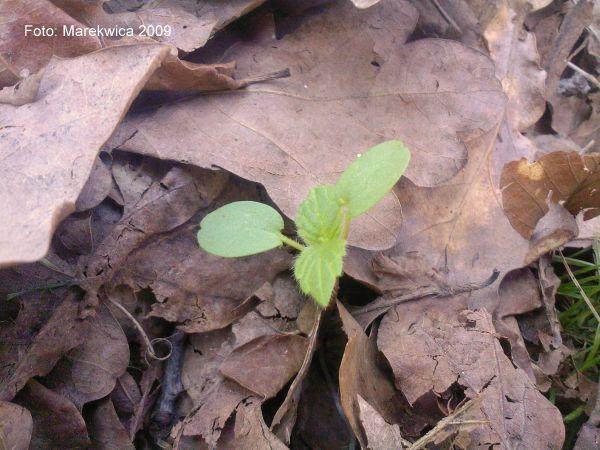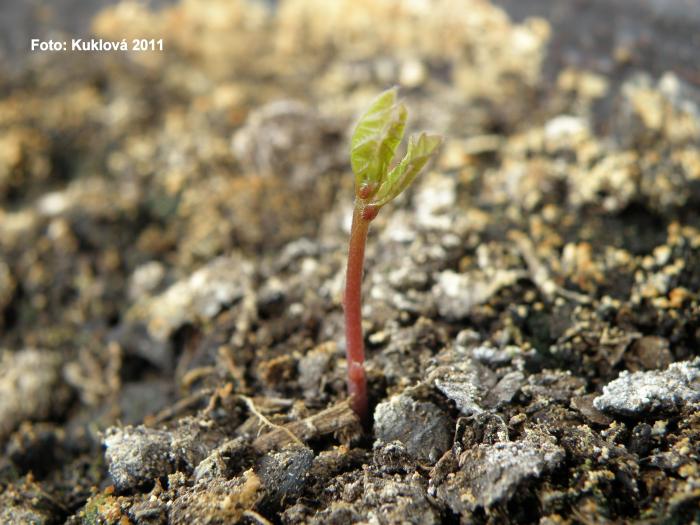Czech University of Life Sciences Prague


Evropský sociální fond
Praha & EU: Investujeme do vaší budoucnosti
Tree Seed, Seedlings and Root Deformations Guide
This Tree Seed, Seedlings and Root Deformations Guide was created in order to help students to recognize seed and seedlings of the principal forest tree species commonly growing in Central Europe. The root deformations are introduced as a serious topic for nursery production and artificial regeneration of forests. This study material was financially supported by the Operational Program Prague - Adaptability (OP PA), project No. CZ.2.217/3.1.00/32083 "Modernization and upgrading of environmental focused education".
The web pages were finalized in the Truba Research Station (Czech University of Life Sciences). Sincere thanks are acorded to members of Forestry and Game Management Research Institute (FGMRI), namely Zdeňka Procházková, Lena Bezděčková and Jarmila Nárovcová for consultations and providing us the opportunity to take pictures of some samples included in the FGMRI collection of deformed roots.
Authors:
Tereza Koňasová (konasova@fld.czu.cz)
Ivan Kuneš (kunes@fld.czu.cz)
Martin Baláš (balas@fld.czu.cz)
Photos used in the Guide were mainly taken by students of the Faculty of Forestry and Wood Science and by the authors.
Content:
Short Introduction
Seed Germination and Dormancy
Seed Germination
Natural Longevity of Tree Seeds
Dormancy
Refernces
Accompanying text was compiled on the basis of literary sources stated in the list of literature (see below).
Seed Germination
On one hand, certain species of mangrove are viviparous, the seeds are germinating before they separate from the parent tree. On the other hand, seed of some species may remain dormant but alive for many years, capable of germinating if an event occurs to break the dormancy state. Between the viviparous and the deeply dormant seed types occur many types of seed which are capable of germination soon after seed shed provided that environmental conditions are suitable.
The seeds survive the unfavourable outer conditions by reducing metabolic activity. Reduced metabolic activity is associated with the drying of the seed, so that the embryo is in a temporarily resting or quiescent state, which in non-dormant seeds can be easily reactivated by suitable conditions. These conditions are (1) Adequate moisture (2) Favourable temperatures (3) Adequate gas exchange and, for some species, (4) Light (KRUGMAN et al. 1974).
Germination consists of three overlapping processes:
(1) Absorption of water mainly by imbibition, causing a swelling of the seed and eventual splitting of the seedcoat,
(2) enzymatic activity and increased respiration and assimilation rates which signal the use of stored food and translocation to growing regions,
(3) cell enlargement and divisions resulting in emergence of radicle and plumule (EVENARI 1957, cited by KRUGMAN et al. 1974).
Types of germination
In epigeal germination anchoring of the young plant by the radicle is followed by rapid elongation of the hypocotyl which grows upwards above the soil surface and then straightens; at the same time the cotyledons and plumule are exposed, to which the seedcoat may or may not still be attached. The plumule then develops into the primary shoot and photosynthetic leaves.
In hypogeal germination, the cotyledons remain confined inside the seed coat and provide nutrients and energy for the germination process (they do not participate on assimilation).


Betula sp. - epigeal type of germination. Quercus sp. - hypogeal type of germination.
Natural Longevity of Tree Seeds
The period for which seed can remain viable without germinating is greatly affected by its quality at the time of collection, its treatment between collection and storage and the conditions in which it is stored (longevity). Nevertheless, seed longevity varies enormously from species to species even if they are given identical treatment and storage conditions. Today two major classes of seed are recognised (ROBERTS 1973):
(1) Orthodox. Seeds which can be dried down to a low MC of around 5% (wet basis) and successfully stored at low or sub-freezing temperatures for long periods. We can distinguish two main types of orthodox seeds: hard-coated orthodox seeds and orthodox seeds without hard seedcoats.
(2) Recalcitrant. Seeds which cannot survive drying below a relatively high moisture content (often in the range 20–50% wet basis) and which cannot be successfully stored for long periods. Orthodox and recalcitrant species sometimes occur within the same genus. E.g. the genera Acer and Ulmus. Unlike orthodox species, in which viability is best preserved by maintaining a minimal respiration rate, it appears that active respiration is necessary to survival of seeds of most recalcitrants.
The term “dormancy” refers to a state of a viable seed which prevents it from germination although it is supplied with the factors normally considered adequate for germination - suitable temperature, moisture and gaseous environment.
Dormancy in nature serves to protect the seed from conditions which are temporarily suitable for germination but which quickly revert to conditions too harsh for survival of the young seedling. In the cool temperate zone the type of embryo dormancy which can be removed only through exposure to low temperatures facilitates subsequent germination in spring, while preventing it in autumn, when the resulting seedling would be unlikely to survive the winter. Dormancy improves the chances of survival in nature and it preserves the seed against temporarily unsuitable conditions such as may occur during the period between seed collection and storage.
Dormancy may be of several different types and sometimes more than one type occurs in the same seed. The simplest grouping distinguishes between (1) exogenous or seedcoat/pericarp dormancy, (2) endogenous or embryo dormancy and (3) combined dormancy, in which both seedcoat and embryo dormancy occur at the same time.
(1) Exogenous or Seedcoat Dormancy
Seeds of some species (e.g. Robinia pseudoacacia, Celtis) have hard, cutinised seedcoats that completely prevent the imbibition of water. Without imbibition renewal of embryo growth and germination are impossible. Physical seedcoat dormancy of this kind occurs most frequently in species adapted to alternating dry and wet seasons. Pretreatment to overcome physical seedcoat dormancy includes physical and biological methods, dry heating and soaking in water or chemical solutions. Any treatment which abrades the seedcoat or in general reduces seedcoat impermeability is commonly known as scarification (BONNER 1984a). Chemical seedcoat dormancy, caused by the presence of chemicals located in the seedcoat but inhibiting germination of the embryo, can usually be overcome by some form of liquid treatment which leaches out the chemicals (for this chemical pretreatment the term maceration can also be used).
(2) Endogenous Dormancy, where the embryo is morphologically underdeveloped
Embryo dormancy is a prominent feature in some temperate genera. Endogenous dormancy occurs in both orthodox and recalcitrant seeds. Endogenous dormancy includes the cases of embryos which are morphologically underdeveloped at the time of separation from the parent tree.
(3) Endogenous Dormancy, where the embryo is morphologically mature but physiologically incapable
It includes the cases of embryos which are morphologically mature at the time of seed dispersal or collection but are physiologically incapable of germination until certain biochemical changes, still little understood, take place.
Overcoming morphological dormancy is based on exposing the seeds to moist warm pretreatment enabling the embryos to develop sufficiently.
Overcoming physiological dormancy (cold stratification) is used when seeds are fully developed at dispersal or collection they are, however, inhibited from immediate germination for physiological reasons. The most effective pretreatment is cold stratification, which approximates to the conditions of overwintering in nature. In other terms cold stratification is a moist cold treatment. In the course of cold stratification the seeds are placed in layers of moisture retaining medium, such as sand, peat or vermiculite, and kept at a cool temperature at approx. 3 to 4 °C for a period, which is commonly between 20 and 60 days.
From another point of view (Forestry Commission Great Britain, Forest Research) two types of dormancy can be distinguished: (1) shallowly dormant species and (2) deeply dormant species.
(1) Among the shallowly dormant species belong most conifers, e.g. firs ((Abies), pines (Pinus) and spruces (Picea) and a few broadleaves, e.g. alders (Alnus) and birches (Betula). All these seeds (whether freshly collected or dry-stored) are slow to germinate and/or only capable of germinating over a narrow range of conditions until pretreated. Pretreatment usually consists of incubating seeds for a relatively short period of time (3 to 12 weeks) under moist conditions at c. 4°C (a so-called prechill).
(2) The category of deeply dormant species includes most broadleaves, e.g. ash (Fraxinus), beech (Fagus), cherry (Prunus) and a few conifer, e.g. juniper (Juniperus) and yew (Taxus). All these seeds (whether freshly collected or stored) are incapable of germinating under any conditions until pretreated. Pretreatment consists of incubating seeds for a relatively long period of time (8 to 64 weeks) under moist conditions. All species can be pretreated either naturally or artificially. All can be pretreated in a moisture retaining medium, a few can be pretreated without. Some need cold only (c. 4°C) others warm (c. 15°C) followed by cold (c. 4°C). Recommended pretreatment durations for individual species are described by each tree in this Catalogue.
This classification is used for characterising seeds of particular tree species in this Forest Seeds Guide.
References
- BONNER, F.T., 1984a: Glossary of seed germination terms for tree seed workers. USDA Forest Service. Gen. Tech. Rep. SO-49, Southern Forest Experiment Station.
- Brockman, C. F., 1968: Trees of North America. A Guide To Field Identification. Western Publishing Company. Published by Golden Press New York, N.Y., pp: 280.
- EVENARI, M., 1957: The physiological action and biological importance of germination inhibitors. Symp. Soc. Exp. Biol. 11: 21–43. Univ. Press, Cambridge.
- GOSLING, P., 2007: Raising trees and shrubs from seeds. Forestry Commission Practice Guide. Forestry Commission, Edinburgh, UK. i–iv + 1–28 pp. ISBN 978-0-85538-736-5.
- JUSTICE, O.L., 1972: Essentials of seed testing. In Seed Biology Vol. 3 (Ed. T.T. Kozlowski). Academic Press New York and London, 301–370.
- KRUGMAN, S.L., STEIN, W.I. and SCHMITT, D.M., 1974: Seed Biology. In Seeds of Woody Plants in the United States, Agriculture Handbook No. 450. For. Service. USDA, Washington D.C.
- WILLAN, R.L., 1985: A Guide to Forest Seed Handling with Special Reference to the Tropics. FAO, Rome, pp: 379. ISBN 92-5-102291-7.
- ROBERTS, E.H., 1973: Predicting the storage life of seeds. Seed Sci. and Technol. 1, 499–514.
- The glossary in this guide has been overtaken from A guide to forest seed handling (WILLAN, R.L., 1985. A Guide to Forest Seed Handling with Special Reference to the Tropics. FAO, Rome, ISBN: 92-5-102291-7, pp: 379.). Originally it was compiled, sometimes with modification, from the following sources:
-
Terminology of Forest Science, Technology Practice and Products. Ed. F. C. Ford - Robertson. Soc. Am. For. Washington, D.C. 1971.
-
A Glossary of Genetics and Cytogenetics. By Reeger and others. Springer-Verlag, Berlin, Heidelberg, New York 1968.
-
Glossary of Botanical Terms commonly used in Range Research. Compiled by W. A. Dayton. USDA Misc. Publication No. 110, Washington D.C., revised 1950.
-
A Glossary of Botanic Terms. B. D. Jacobsen. 4th Edn. 1928. Duckworth, London.
-
A Dictionary of Scientific Terms. I. F. Henderson and W. D. Henderson. 4th Edn. by J. H. Kenneth 1949. Oliver and Boyd, Edinburgh.
-
Seeds. The Yearbook of Agriculture. USDA Washington D.C. 1961.
-
Seeds of Woody Plants in the United States. Agriculture Handbook No. 450. USDA Forest Service, Washington D.C. 1974.
-
The Methodology of Conservation of Forest Genetic Resources. L. R. Roche. FAO, Rome 1975.
-
Viability of Seeds. Ed. E. H. Roberts. Syracuse University Press 1972.
-
Glossary of Seed Germination Terms for Tree Seed Workers. F. T. Bonner. USDA Forest Service Gen. Tech. Rep. SO-49, Southern Forest Experiment Station 1984.
-
Glossary for forest tree improvement workers. E. B. Snyder, USDA, Forest Service 1972.
-
Eucalyptus seed. D. J. Boland et al. CSIRO, Australia 1980.
-
Oxford English Dictionary, 1933 edition.
-
Penguin Dictionary of Science. E.B. Uvarov, D.R. Chapman and A. Isaacs. 5th Edn. 1979. Penguin Books.
